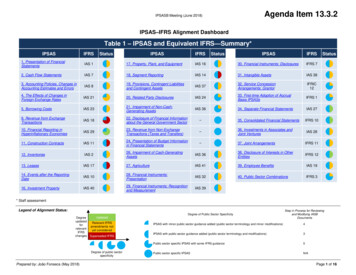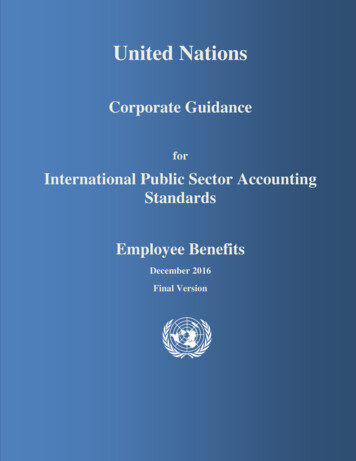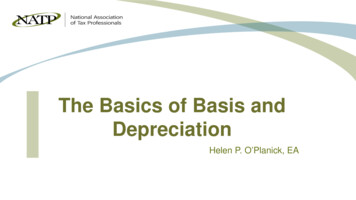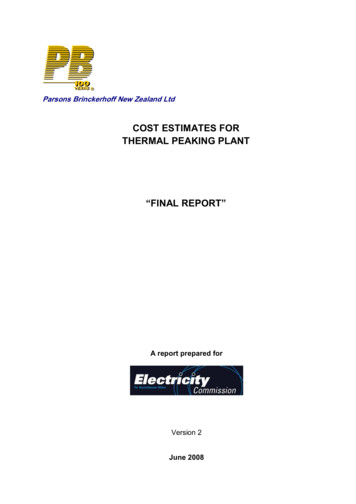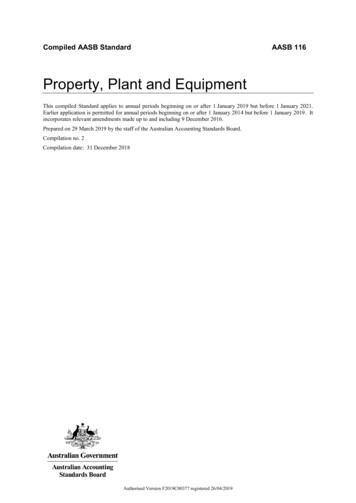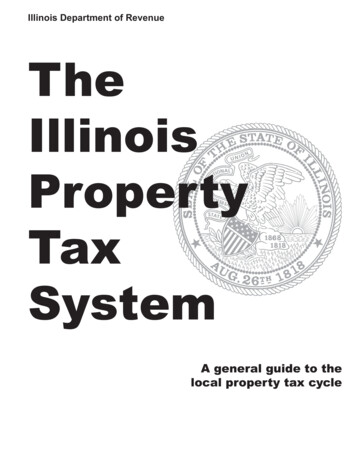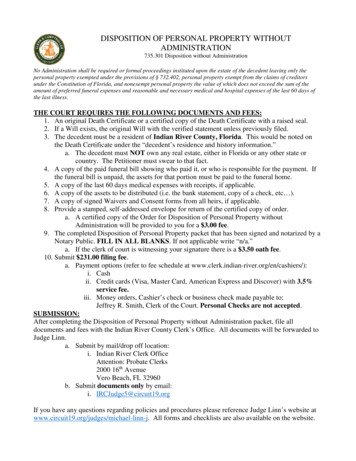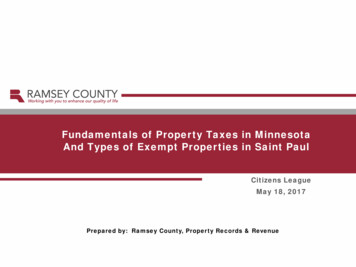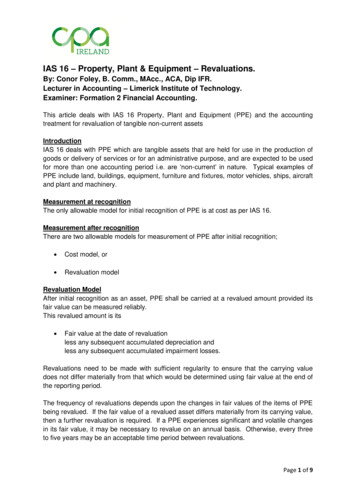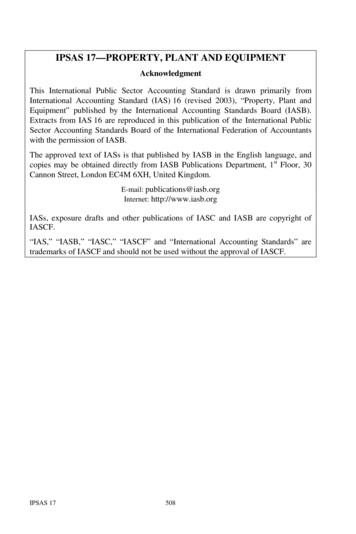
Transcription
IPSAS 17—PROPERTY, PLANT AND EQUIPMENTAcknowledgmentThis International Public Sector Accounting Standard is drawn primarily fromInternational Accounting Standard (IAS) 16 (revised 2003), “Property, Plant andEquipment” published by the International Accounting Standards Board (IASB).Extracts from IAS 16 are reproduced in this publication of the International PublicSector Accounting Standards Board of the International Federation of Accountantswith the permission of IASB.The approved text of IASs is that published by IASB in the English language, andcopies may be obtained directly from IASB Publications Department, 1st Floor, 30Cannon Street, London EC4M 6XH, United Kingdom.E-mail: publications@iasb.orgInternet: http://www.iasb.orgIASs, exposure drafts and other publications of IASC and IASB are copyright ofIASCF.“IAS,” “IASB,” “IASC,” “IASCF” and “International Accounting Standards” aretrademarks of IASCF and should not be used without the approval of IASCF.IPSAS 17508
CONTENTSParagraphIntroduction . IN1-IN10Objective .1Scope .2–12Heritage Assets .8–11Government Business Enterprises .12Definitions .13Recognition .14–25Infrastructure Assets .21Initial Costs .22Subsequent Costs .23–25Measurement at Recognition .26–41Elements of Cost .30–36Measurement of Cost .37–41Measurement after Recognition .42–87Cost Model .43Revaluation Model .44–58Depreciation .59–78Depreciable Amount and Depreciation Period .66–75Depreciation Method .76–78Impairment .79Compensation for Impairment .80–81Derecognition .82–87Disclosure .88–94Transitional Provisions .95–106Effective Date . 107–108Withdrawal of IPSAS 17 (2001) .509109IPSAS 17PUBLIC SECTORIPSAS 17—PROPERTY, PLANT AND EQUIPMENT
Appendix: Amendments to Other IPSASsIllustrative Guidance 1 – Frequency of Revaluation of Property, Plant andEquipmentImplementation Guidance 2 - Illustrative Disclosure ExamplesBasis for ConclusionsTable of ConcordanceComparison with IAS 16IPSAS 17510
511IPSAS 17PUBLIC SECTORInternational Public Sector Accounting Standard 17, “Property, Plant andEquipment” (IPSAS 17) is set out in paragraphs 1-109 and the Appendix. All theparagraphs have equal authority. IPSAS 17 should be read in the context of itsobjective, the Basis for Conclusion and the Preface to International Public SectorAccounting Standards. IPSAS 3, “Accounting Policies, Changes in AccountingEstimates and Errors” provides a basis for selecting and applying accounting policiesin the absence of explicit guidance.
PROPERTY, PLANT AND EQUIPMENTIntroductionIN1.International Public Sector Accounting Standard (IPSAS) 17, “Property,Plant and Equipment,” replaces 17, “Property, Plant and Equipment”(issued December 2001), and should be applied for annual reportingperiods beginning on or after January 1, 2008. Earlier application isencouraged.Reasons for Revising IPSAS 17IN2.The International Public Sector Accounting Standards Board developed thisrevised IPSAS 17 as a response to the International Accounting StandardsBoard’s project on Improvement to International Accounting Standards andits own policy to converge public sector accounting standards with privatesector standards to the extent appropriate.IN3.In developing this revised IPSAS 17, the IPSASB adopted the policy ofamending the IPSAS for those changes made to the former IAS 16,“Property, Plant and Equipment” made as a consequence of the IASB’simprovements project, except where the original IPSAS had varied from theprovisions of IAS 16 for a public sector specific reason; such variances areretained in this IPSAS 16 and are noted in the Comparison with IAS 16.Any changes to IAS 16 made subsequent to the IASB’s improvementsproject have not been incorporated into IPSAS 16.Changes from Previous RequirementsIN4.The main changes from the previous version of IPSAS 17 are describedbelow.DefinitionsIN5.IPSAS 17In paragraph 13: The Standard defines the terms “carrying amount,” “impairment loss,”“impairment loss of a non-cash-generating asset,” “recoverableamount” and “recoverable service amount” due to the issuance ofIPSAS 21, “Impairment of Non-Cash-Generating Assets.” Previously,IPSAS 17 did not define these terms. The Standard amends the definition of “residual value.” The amendeddefinition requires an entity to measure the residual value of an item ofproperty, plant and equipment as the amount it estimates it wouldreceive currently from the disposal of the asset if the asset were alreadyof the age and in the condition expected at the end of its useful life.The previous definition in IPSAS 17 did not clarify that residual valuewas a current amount.512
The Standard define the term “entity-specific value,” which refers to“the present value of the cash flows an entity expects to arise from thecontinuing use of an asset and from its disposal at the end of its usefullife or expects to incur when settling a liability.” This term is usedwhere relevant in determining whether an asset exchange transactionhas commercial substance. Guidance on how to judge whether an assetexchange transaction has commercial substance is also provided (seeparagraphs 38-40). Previously, IPSAS 17 did not contain this definitionand the related guidance.RecognitionIN6.The Standard requires an entity to apply the general asset recognitionprinciple to all property, plant and equipment costs at the time they areincurred, including initial costs and subsequent expenditures (seeparagraphs 14, 19, 22, 24-25). Previously, IPSAS 17 contained tworecognition principles one applied to initial costs while another applied tosubsequent expenditures.IN7.The Standard clarifies in paragraph 23 that the costs of day-to-day servicingof property, plant and equipment are recognized in surplus or deficit.Previously, IPSAS 17 did not make this very clear.Measurement at RecognitionIN8.The Standard requires an entity to include the estimate of assetdismantlement, removal and restoration costs as an element of cost ofproperty, plant and equipment, including the obligations which the entityincurs both when the asset is acquired and when it is used at subsequentperiods, except when it is used to produce inventories (see paragraph 30).IPSAS 12 applies to the obligations for dismantling, removing and restoringthat are incurred during the period of using the item to produce inventories.Previously, IPSAS 17 included within the cost of property, plant andequipment only the obligation which the entity incurs when the item isacquired.IN9.The Standard requires an entity to measure an item of property, plant andequipment acquired in exchange for a non-monetary asset or assets, or acombination of monetary and non-monetary assets, at fair value unless: theexchange transaction lacks commercial substance; or the fair value ofneither the asset given up nor the asset received can be reliably measured(see paragraphs 38 to 40). Previously, IPSAS 17 divided asset exchangetransactions into exchanges between similar assets and exchanges betweendissimilar assets. The different categories of exchange were subject toIPSAS 17513PUBLIC SECTORPROPERTY, PLANT AND EQUIPMENT
PROPERTY, PLANT AND EQUIPMENTdifferent accounting treatments. For exchange of similar assets, the cost ofthe asset received was the carrying amount of the asset given up. Forexchange of dissimilar assets, the cost was the fair value of the asset givenup adjusted by the amount of any cash or cash equivalent transferred.DepreciationIN10.The Standard requires an entity to determine the depreciation chargeseparately for each significant part of an item of property, plant andequipment (see paragraphs 59 to 63). Previously, IPSAS 17 did not makethis clear.IN11.The Standard requires an entity to begin depreciating an item of property,plant and equipment when it is available for use and to continuedepreciating it until it is derecognized, even if during that period the item isidle (see paragraph 71). Previously, IPSAS 17 did not specify whendepreciation of an item began. It specified that an entity should ceasedepreciating an item when the item was retired from active use and washeld for disposal.Compensation for ImpairmentsIN12.The Standard requires an entity to include in surplus or deficitcompensation from third parties for an item of property, plant andequipment that was impaired, lost or given up when the compensationbecomes receivable (see paragraphs 80). Previously, IPSAS 17 did notinclude these requirements.DerecognitionIN13.The Standard requires an entity to derecognize the carrying amount of anitem of property, plant and equipment that it disposes of on the date thecriteria for the sale of goods in IPSAS 9, “Revenue from ExchangeTransactions” are met (see paragraph 84). Previously, IPSAS 17 did notspecify that an entity was to use the criteria contained in IPSAS 9 todetermine the date on which it derecognized the carrying amount of adisposed item of property, plant and equipment.IN14.The Standard requires an entity to derecognize the carrying amount of apart of an item of property, plant and equipment if that part has beenreplaced and the entity has included the cost of the replacement in thecarrying amount of the item (see paragraph 85). Previously, IPSAS 17 didnot apply its derecognition principle to replaced parts. Its recognitionprinciple for subsequent expenditures effectively precluded the cost of areplacement from being included in the carrying amount of the item.Transitional ProvisionsIPSAS 17514
IN15.The Standard requires the entity to recognize the effects of the initialrecognition of property, plant and equipment as an adjustment to theopening balance of accumulated surpluses or deficits for the period inwhich the property, plant and equipment is initially recognized inaccordance with IPSAS 17 (see paragraph 97).IN16.The Standard clarifies that an entity shall retrospectively apply accountingpolicies in accordance with IPSAS 3, “Accounting Policies, Changes inAccounting Estimates and Errors” when it initially recognizes an item ofproperty, plant and equipment at cost in accordance with IPSAS 17 (seeparagraph 99).Amendments to Other IPSASsIN17.The Standard includes an authoritative appendix of amendments to otherIPSASs that are not part of the IPSASs Improvements project and will beimpacted as a result of the proposals in this IPSAS.515IPSAS 17PUBLIC SECTORPROPERTY, PLANT AND EQUIPMENT
PROPERTY, PLANT AND EQUIPMENTINTERNATIONAL PUBLIC SECTOR ACCOUNTINGSTANDARD 17—PROPERTY, PLANT AND EQUIPMENTObjective1.The objective of this Standard is to prescribe the accounting treatment forproperty, plant and equipment so that users of financial statements can discerninformation about an entity’s investment in its property, plant and equipmentand the changes in such investment. The principal issues in accounting forproperty, plant and equipment are the recognition of the assets, thedetermination of their carrying amounts and the depreciation charges andimpairment losses to be recognized in relation to them.Scope2.An entity that prepares and presents financial statements under theaccrual basis of accounting shall apply this Standard in accounting forproperty, plant and equipment, except:(a)When a different accounting treatment has been adopted inaccordance with another International Public Sector AccountingStandard; and(b)In respect of heritage assets. However, the disclosure requirementsof paragraphs 88, 89 and 92 apply to those heritage assets that arerecognized.3.This Standard applies to all public sector entities other than GovernmentBusiness Enterprises.4.This Standard applies to property, plant and equipment including:(a)Specialist military equipment; and(b)Infrastructure assets.The transitional provisions in paragraphs 95 to 104 provide relief from therequirement to recognize all property, plant and equipment during the fiveyear transitional period.5.This Standard does not apply to:(a)Biological assets related to agricultural activity (see the relevantinternational or national accounting standard dealing with agriculture);or(b)Mineral rights and mineral reserves such as oil, natural gas and similarnon-regenerative resources (see the relevant international or nationalaccounting standard dealing with mineral rights, mineral reserves andsimilar non-regenerative resources).IPSAS 17516
However, this Standard applies to property, plant and equipment used todevelop or maintain the assets described in 5(a) or 5(b).6.Other International Public Sector Accounting Standards may requirerecognition of an item of property, plant and equipment based on an approachdifferent from that in this Standard. For example, IPSAS 13, “Leases”requires an entity to evaluate its recognition of an item of leased property,plant and equipment on the basis of the transfer of risks and rewards.However, in such cases other aspects of the accounting treatment for theseassets, including depreciation, are prescribed by this Standard.7.An entity shall apply this Standard to property that is being constructed ordeveloped for future use as investment property but does not yet satisfy thedefinition of “investment property” in IPSAS 16, “Investment Property.”Once the construction or development is complete, the property becomesinvestment property and the entity is required to apply IPSAS 16. IPSAS 16also applies to investment property that is being redeveloped for continuedfuture use as investment property. An entity using the cost model forinvestment property in accordance with IPSAS 16 shall use the cost model inthis Standard.Heritage Assets8.This Standard does not require an entity to recognize heritage assets thatwould otherwise meet the definition of, and recognition criteria for, property,plant and equipment. If an entity does recognize heritage assets, it must applythe disclosure requirements of this Standard and may, but is not required to,apply the measurement requirements of this Standard.9.Some assets are described as “heritage assets” because of their cultural,environmental or historical significance. Examples of heritage assets includehistorical buildings and monuments, archaeological sites, conservation areasand nature reserves, and works of art. Certain characteristics, including thefollowing, are often displayed by heritage assets (although thesecharacteristics are not exclusive to such assets):(a)Their value in cultural, environmental, educational and historical termsis unlikely to be fully reflected in a financial value based purely on amarket price;(b)Legal and/or statutory obligations may impose prohibitions or severerestrictions on disposal by sale;(c)They are often irreplaceable and their value may increase over timeeven if their physical condition deteriorates; and(d)It may be difficult to estimate their useful lives, which in some casescould be several hundred years.517IPSAS 17PUBLIC SECTORPROPERTY, PLANT AND EQUIPMENT
PROPERTY, PLANT AND EQUIPMENTPublic sector entities may have large holdings of heritage assets that havebeen acquired over many years and by various means, including purchase,donation, bequest and sequestration. These assets are rarely held for theirability to generate cash inflows, and there may be legal or social obstacles tousing them for such purposes.10.Some heritage assets have service potential other than their heritage value, forexample, an historic building being used for office accommodation. In thesecases, they may be recognized and measured on the same basis as other itemsof property, plant and equipment. For other heritage assets, their servicepotential is limited to their heritage characteristics, for example, monumentsand ruins. The existence of alternative service potential can affect the choiceof measurement base.11.The disclosure requirements in paragraphs 88 to 94 require entities to makedisclosures about recognized assets. Therefore, entities that recognizeheritage assets are required to disclose in respect of those assets such mattersas, for example:(a)The measurement basis used;(b)The depreciation method used, if any;(c)The gross carrying amount;(d)The accumulated depreciation at the end of the period, if any; and(e)A reconciliation of the carrying amount at the beginning and end of theperiod showing certain components thereof.Government Business Enterprises12. The “Preface to International Public Sector Accounting Standards” issued bythe International Public Sector Accounting Standards Board (IPSASB)explains that Government Business Enterprises (GBEs) apply InternationalFinancial Reporting Standards (IFRSs) issued by the International AccountingStandards Board (IASB). GBEs are defined in IPSAS 1, “Presentation ofFinancial Statements.”Definitions13.The following terms are used in this Standard with the meaningsspecified:Carrying amount (for the purpose of this Standard) is the amount atwhich an asset is recognized after deducting any accumulateddepreciation and accumulated impairment losses.Class of property, plant and equipment means a grouping of assets of asimilar nature or function in an entity’s operations that is shown as asingle item for the purpose of disclosure in the financial statements.IPSAS 17518
Cost is the amount of cash or cash equivalents paid and the fair value ofthe other consideration given to acquire an asset at the time of itsacquisition or construction.Depreciation is the systematic allocation of the depreciable amount of anasset over its useful life.Depreciable amount is the cost of an asset, or other amount substitutedfor cost, less its residual value.Entity-specific value is the present value of the cash flows an entityexpects to arise from the continuing use of an asset and from its disposalat the end of its useful life or expects to incur when settling a liability.Exchange transactions are transactions in which one entity receivesassets or services, or has liabilities extinguished, and directly givesapproximately equal value (primarily in the form of cash, goods, services,or use of assets) to another entity in exchange.Fair value is the amount for which an asset could be exchanged, or aliability settled, between knowledgeable, willing parties in an arm’slength transaction.An impairment loss of a cash-generating asset is the amount by which thecarrying amount of an asset exceeds its recoverable amount.An impairment loss of a non-cash-generating asset is the amount bywhich the carrying amount of an asset exceeds its recoverable serviceamount.Non-exchange transactions are transactions that are not exchangetransactions. In a non-exchange transaction, an entity either receivesvalue from another entity without directly giving approximately equalvalue in exchange, or gives value to another entity without directlyreceiving approximately equal value in exchange.Property, plant and equipment are tangible items that:(a)Are held for use in the production or supply of goods or services,for rental to others, or for administrative purposes; and(b)Are expected to be used during more than one reporting period.Recoverable amount is the higher of a cash-generating asset’s fair valueless costs to sell and its value in use.Recoverable service amount is the higher of a non-cash-generating asset’sfair value less costs to sell and its value in use.The residual value of an asset is the estimated amount that an entitywould currently obtain from disposal of the asset, after deducting the519IPSAS 17PUBLIC SECTORPROPERTY, PLANT AND EQUIPMENT
PROPERTY, PLANT AND EQUIPMENTestimated costs of disposal, if the asset were already of the age and in thecondition expected at the end of its useful life.Useful life is:(a)The period over which an asset is expected to be available for useby an entity; or(b)The number of production or similar units expected to be obtainedfrom the asset by an entity.Terms defined in other International Public Sector AccountingStandards are used in this Standard with the same meaning as in thoseother Standards, and are reproduced in the Glossary of Defined Termspublished separately.Recognition14.The cost of an item of property, plant and equipment shall be recognizedas an asset if, and only if:(a)It is probable that future economic benefits or service potentialassociated with the item will flow to the entity; and(b)The cost or fair value of the item can be measured reliably.17.Spare parts and servicing equipment are usually carried as inventory andrecognized in surplus or deficit as consumed. However, major spare parts andstand-by equipment qualify as property, plant and equipment when an entityexpects to use them during more than one period. Similarly, if the spare partsand servicing equipment can be used only in connection with an item ofproperty, plant and equipment, they are accounted for as property, plant andequipment.18.This standard does not prescribe the unit of measure for recognition, i.e. whatconstitutes an item of property, plant and equipment. Thus, judgment isrequired in applying the recognition criteria to an entity’s specificcircumstances. It may be appropriate to aggregate individually insignificantitems, such as library books, computer peripherals and small items ofequipment, and to apply the criteria to the aggregate value.19.An entity evaluates under this recognition principle all its property, plant andequipment costs at the time they are incurred. These costs include costsincurred initially to acquire or construct an item of property, plant andequipment and costs incurred subsequently to add to, replace part of, orservice it.20.Specialist military equipment will normally meet the definition of property,plant and equipment and should be recognized as an asset in accordance withthis Standard.IPSAS 17520
Infrastructure Assets21. Some assets are commonly described as “infrastructure assets”. While there isno universally accepted definition of infrastructure assets, these assets usuallydisplay some or all of the following characteristics:(a)They are part of a system or network;(b)They are specialized in nature and do not have alternative uses;(c)They are immovable; and(d)They may be subject to constraints on disposal.Although ownership of infrastructure assets is not confined to entities in thepublic sector, significant infrastructure assets are frequently found in thepublic sector. Infrastructure assets meet the definition of property, plant andequipment and should be accounted for in accordance with this Standard.Examples of infrastructure assets include road networks, sewer systems, waterand power supply systems and communication networks.Initial Costs22. Items of property, plant and equipment may be required for safety orenvironmental reasons. The acquisition of such property, plant andequipment, although not directly increasing the future economic benefits orservice potential of any particular existing item of property, plant andequipment, may be necessary for an entity to obtain the future economicbenefits or service potential from its other assets. Such items of property,plant and equipment qualify for recognition as assets because they enable anentity to derive future economic benefits or service potential from relatedassets in excess of what could be derived had those items not been acquired.For example, fire safety regulations may require a hospital to retro-fit newsprinkler systems. These enhancements are recognized as an asset becausewithout them the entity is unable to operate the hospital in accordance withthe regulations. However, the resulting carrying amount of such an asset andrelated assets is reviewed for impairment in accordance with IPSAS 21,“Impairment of Non-Cash-Generating Assets.”Subsequent Costs23. Under the recognition principle in paragraph 14, an entity does not recognizein the carrying amount of an item of property, plant and equipment the costsof the day-to-day servicing of the item. Rather, these costs are recognized insurplus or deficit as incurred. Costs of day-to-day servicing are primarily thecosts of labor and consumables, and may include the cost of small parts. Thepurpose of these expenditures is often described as for the “repairs andmaintenance” of the item of property, plant and equipment.24.Parts of some items of property, plant and equipment may require replacementat regular intervals. For example, a road may need resurfacing every few521IPSAS 17PUBLIC SECTORPROPERTY, PLANT AND EQUIPMENT
PROPERTY, PLANT AND EQUIPMENTyears, a furnace may require relining after a specified number of hours of use,or aircraft interiors such as seats and galleys may require replacement severaltimes during the life of the airframe. Items of property, plant and equipmentmay also be required to make a less frequently recurring replacement, such asreplacing the interior walls of a building, or to make a non-recurringreplacement. Under the recognition principle in paragraph 14, an entityrecognizes in the carrying amount of an item of property, plant and equipmentthe cost of replacing part of such an item when that cost is incurred if therecognition criteria are met. The carrying amount of those parts that arereplaced is derecognized in accordance with the derecognition provisions ofthis Standard (see paragraphs 82 to 87).25.A condition of continuing to operate an item of property, plant and equipment(for example, an aircraft) may be performing regular major inspections forfaults regardless of whether parts of the item are replaced. When each majorinspection is performed, its cost is recognized in the carrying amount of theitem of property, plant and equipment as a replacement if the recognitioncriteria are satisfied. Any remaining carrying amount of the cost of previousinspection (as distinct from physical parts) is derecognized. This occursregardless of whether the cost of the previous inspection was identified in thetransaction in which the item was acquired or constructed. If necessary, theestimated cost of a future similar inspection may be used as an indication ofwhat the cost of the existing inspection component was when the item wasacquired or constructed.Measurement at Recognition26.An item of property, plant and equipment that qualifies for recognitionas an asset shall be measured at its cost.27.Where an asset is acquired through a non-exchange transaction, its costshall be measured at its fair value as at the date of acquisition.28.An item of property, plant and equipment may be acquired through a nonexchange transaction. For example, land may be contributed to a localgovernment by a developer at no or nominal consideration, to enable the localgovernment to develop parks, roads and paths in the development. An assetmay also be acquired through a non-exchange transaction by the exercise ofpowers of sequestration. Under these circumstances the cost of the item is itsfair value as at the date it is acquired.29.For the purposes of this Standard, the measurement at recognition of an itemof property, plant and equipment, acquired at no or nominal cost, at its fairvalue consistent with the requirements of paragraph 27, does not constitute arevaluation. Accordingly, the revaluation requirements in paragraph 44, andthe supporting commentary in paragraphs 45 to 50, only apply where an entityIPSAS 17522
elects to revalue an item of property, plant and equipment in subsequentreporting periods.Elements of Cost30. The cost of an item of property, plant and equipment comprises:31.(a)Its purchase price, including import duties and non-refundablepurchase taxes, after deducting trade discounts and rebates.(b)Any costs directly attributable to bringing the asset to the location andcondition necessary for it to be capable of operating in the mannerintended by management.(c)The initial estimate of the costs of dismantling and removing the itemand restoring the site on which it is located, the obligation for which anentity incurs either when t
property, plant and equipment as the amount it estimates it would receive currently. from the disposal of the asset if the asset were already of the age and in the condition expected at the end of its useful life. The previous definition in IPSAS 17 did not clarify that residual value was a current amount. IPSAS 17 512
